TERROR TOWN, USA published by:
WILDBLUE PRESS
P.O. Box 102440
Denver, Colorado 80250
Publisher Disclaimer: Any opinions, statements of fact or fiction, descriptions, dialogue, and citations found in this book were provided by the author, and are solely those of the author. The publisher makes no claim as to their veracity or accuracy, and assumes no liability for the content.
Copyright 2021 by John Ferak
All rights reserved. No part of this book may be reproduced in any form or by any means without the prior written consent of the Publisher, excepting brief quotes used in reviews.
WILDBLUE PRESS is registered at the U.S. Patent and Trademark Offices.
ISBN 978-1-952225-68-0 Trade Paperback
ISBN 978-1-952225-67-3 eBook
Cover design 2021 WildBlue Press. All rights reserved.
Interior Formatting/Cover Design by Elijah Toten
www.totencreative.com
PROLOGUE
SUMMER OF 1983
I was ten years old and growing up in Joliet, Illinois, an industrial, blue-collar Midwestern city that had a Caterpillar plant with 7,000 jobs. That summer, my life revolved around Little League baseball games at St. Joes Park off Theodore Street and keeping up with the busy Mass schedule as an altar boy at St. Mary Nativity Catholic Church on Broadway Street. I grew up in a two-story, white-sided house with a horseshoe driveway at 1028 Gardner Street, along Route 52. When I wasnt playing second base on the Little League diamond, one of the neighbor kids and I tossed a red rubber ball in our long, gravel driveway, and we made up our own baseball game.
Family was always around our house, and when relatives werent gathered on Gardner Street, we were over at my grandparents house. They lived in the same neighborhood, two streets behind our house. I could run from my yard to my grandparents house on Retta Court in less than a minute.
The summer of 1983 was memorable for me, first because of the intense heat. Summers near Chicago are always hot, but 1983 was a historic scorcher. Temperatures were in the 90s and triple digits for weeks on end, and there was hardly any rain. I remember the Fourth of July. Oh, what a night. Family and some of the neighbors gathered on lawn chairs in my parents backyard, and one of our guests brought over a bag of fireworks, which may have been illegal back then. One of the bottle rockets whizzed into the air, as expected, and then made a hard landing in the backyard right behind my house. That mans backyard looked like a pile of straw because of the drought. Sure enough, an orange glow appeared. Under the dark sky, the bottle rocket had started a small grass fire. A couple of my uncles leapt from their lawn chairs and did their best Carl Lewis imitation, sprinting as fast as they could to stamp out the fire with their gym shoes. It worked. Crisis averted. There was no need to call the East Joliet Volunteer Fire Department.
I wish I could say the errant bottle rocket was my scariest moment that summer, but it wasnt. Even though I was only ten, I kept up on the news and took an interest in reading the daily Joliet newspaper, mainly because I was a sports junkie, and I was obsessed with reading the Major League Baseball box scores and the players statistics. Even though sports consumed my life at ten, I couldnt miss the agony and tragedy splashed across the front page of my parents newspaper. And if I missed it at home, I was certain to see it spread across my grandparents kitchen table two streets away.
A crazed madman, like Joliet had never seen, was on the prowl, maiming and torturing along the way. All of his victims were losing their lives in truly wicked ways. About two weeks before I returned to start fifth grade at St. Mary Nativity, one of the summers gruesome killings hit close to home. Ed Garland, the owner of our friendly and dependable neighborhood full-service gas station, lost one of his children during the serial-killing spree. About a week later, a quarter-mile up the street from my yard, the Will County Sheriffs deputies had converged upon a two-story house along Mills Road where an older widow lived all alone. The Will County Coroners Office arrived to take away her body. Another Joliet Township murder victim, what in the world was going on?
Growing up in Joliet was no longer about keeping up on the wins and losses for the Chicago White Sox and the Chicago Cubs or trying to find my favorite Topps baseball cards when I tagged along with my parents to the grocery store. Up to that point in my life, death was a foreign topic to me. I hadnt lost any immediate family members, yet. And the idea of murder, someone being killed for no apparent reason, was unfathomable. But now here it was. The newspaper kept running stories about a killer on the loose, and his tally of victims kept mounting, month after month, that terribly hot summer. Even though I was only ten, I could not escape or avoid the terror and panic all around me. It was no longer a wise idea to leave your house unlocked or throw your keys on the front seat of your car or truck, as people around Joliet commonly did back then.
Ten years later, I was a sophomore in college studying journalism at Eastern Illinois University. That summer of 1993, I returned to Joliet, my hometown, as a newspaper reporting intern, where I had a chance to hear first-hand stories from well-known Joliet Herald-News columnist John Whiteside and many other seasoned journalists who covered the 1983 summer of terror as well as the ensuing murder trials.
After college, I disconnected with my hometown and worked in newspapers across the Midwest, including Indiana, Wisconsin and nearly a decade in Nebraska. But as the newspaper era was dying, other opportunities arose and online journalism was booming. In 2017, I returned to Joliet as reporter and editor for Patch. The first few months, I spent a lot of time re-familiarizing myself with Joliet given how much it grew. When I was a kid, Joliet had nearly 80,000 people. Now, it was 150,000. I spent a lot of time getting to know the key people Id wind up writing about, from time to time, covering Joliet politics, local businesses or the Will County Courthouse since Joliet was the county seat.
One time, I met up for lunch at Jamesons Pub on Black Road with attorney Frank Cservenyak and several members of his Joliet law firm, Rathbun, Cservenyak & Kozol. During lunch, Cservenyak remarked that I should consider writing about Milton Johnson, Will Countys most notorious serial killer, as one of my next true-crime books.
One of Cservenyaks law partners, attorney Stephen White, was intricately involved with the case.
And so began my research into one of the countrys most terrorizing mass murderers, who just happened to be from my hometown. Around Illinois and across the nation, the names of John Wayne Gacy and Richard Speck are regarded as two of the most terrifying serial killers on the planet, but as many long-time residents of Joliet and Will County know, theres another raging madman whose sadistic nature rivals that of Gacy and Speck.
Some people refer to them as serial killers; others call them spree killers or mass murderers.
Attorney Stephen White has his own insight into Milton Johnson.
Milton Johnson was a situation killer, White told me when we crossed paths inside the new Will County Courthouse in February 2021.
There have been numerous books, television mini-series and movies depicting the lives and unspeakable crimes committed by suburban Chicago clown-killer John Wayne Gacy and Chicago nurse killer Richard Speck.
The same cant be said for Milton Johnson.
And yet Johnsons crimes are as frightening as those committed by Gacy and Speck put together.















